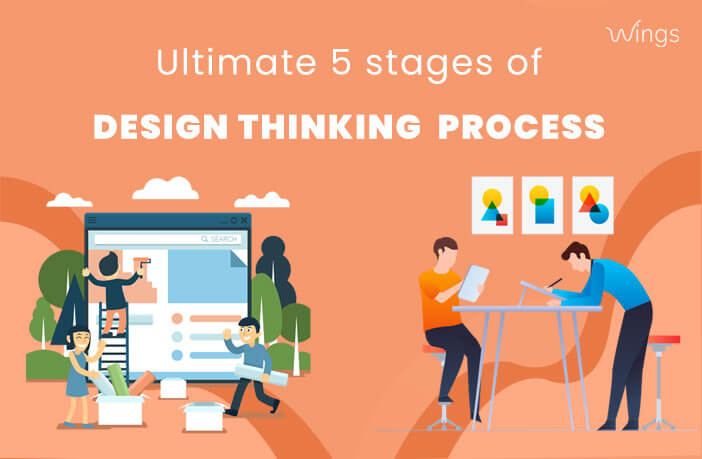Ultimate 5 stages of Design Thinking Process

The designer does not begin with some preconceived ideas. Rather, the idea is the result of observation, and the design is a product of that idea. Designing is the most important phase when you are developing any website or application, whether it is your first or 500th. Always keep in mind that design should be according to user choice or related to the product. It’s the secret sauce, after all; the key to progress and success. So let’s talk about how the design thinking process works?
Yes, the design thinking process? It sounds weird but to have a successful website or application you must be aware of the design thinking process. So let’s go more in detail.
What is the Design Thinking Process?
Design Thinking is a “process for creative problem-solving.” Design Thinking is a methodology that aims to tackle highly complex problems. It is a non-linear, iterative process that seeks to understand users, challenge assumptions, redefine problems and create innovative solutions to prototype and test to see which works best with your users and how to best refine them.
The Design Thinking Process typically boils down to the five steps:
1. Empathize
2. Define
3. Ideate
4. Prototype
5. Test
Below, we walk through each step of the Design Thinking Process in detail:
1. Empathize
The first stage of the Design Thinking Process is to gain an empathic understanding of the problem you are trying to solve, according to user research. It means trying to understand the user’s wants, needs, and objectives. This means observing and engaging with people in order to understand them on a psychological and emotional level. You have to keep your assumptions aside. Armed with first-hand insights, you’ll be able to design with real users in mind.
2. Define
The second stage in the Design Thinking Process is dedicated to defining the problem. First, you will accumulate all the information you created and gathered from the Empathize stage and start piecing them together. You analyze your observations and synthesize them to define the core problems you and your team have identified so far. The resulting problem statement should be captured in a human-centered manner rather than focused on business goals. At the end of the defined phase, you will have a clear problem statement.
3. Ideate
The third stage in the Design Thinking Process marks the transition from identifying problems to exploring solutions. Designers come up with maximum creativity, new angles, and ideas as much as possible which means you have to think out of the box. it’s crucial to point out that the ideation stage is a judgment-free zone! Here we prioritize breadth over depth as we look for a diverse range of ideas to prototype and test with real people.
4. Prototype
The fourth step in the Design Thinking process is all about experimentation and turning ideas into tangible products. A prototype is essentially a scaled-down version of a product representation on a simple paper model or a more interactive digital representation. After this, putting each solution to the test and highlighting any constraints and flaws. By this stage, the proposed solutions may be accepted, improved, redesigned, or rejected depending on how they fare in prototype form. This ensures that the final design actually helps to solve the user’s problem and is a delight to use!
5. Test
The fifth stage in the Design Thinking process is dedicated to testing: putting your prototypes in front of real users and seeing their feedback. Designers can move to previous stages in the process to make further iterations, alterations, and refinements to rule out alternative solutions. It will quickly highlight any design flaws that need to be addressed. The results of the testing stage may require you to revisit the empathize stage for a few more ideation sessions before you create that winning prototype.
Conclusion
The Design Thinking Process is iterative and non-linear. It will end up with the best product possible because we’ve kept the user in the center of the process, where the user is actually going to use your solutions. We’ve listened to them, gathered feedback, and designed the best website or application which meets their needs. This process is able to get to the heart of their users’ needs and find effective solutions to fulfill them. Are you looking for a designer for your upcoming coming project who follows the Design Thinking Process then just drop a message here and we will be back with you within 24hrs to solve your problem.

















